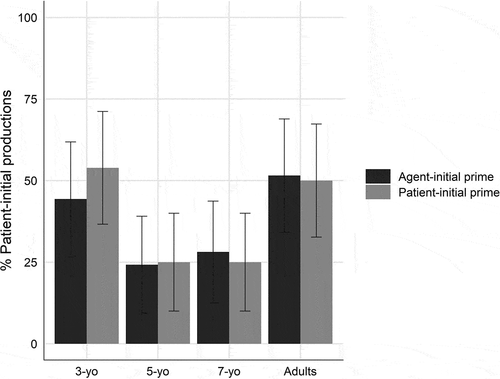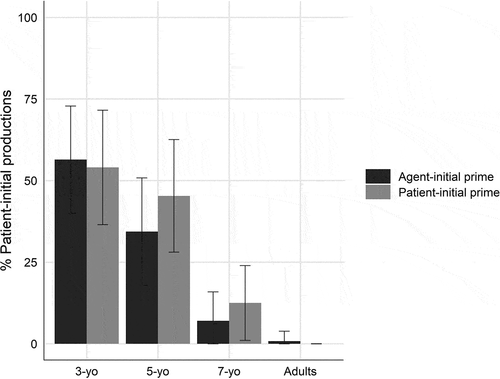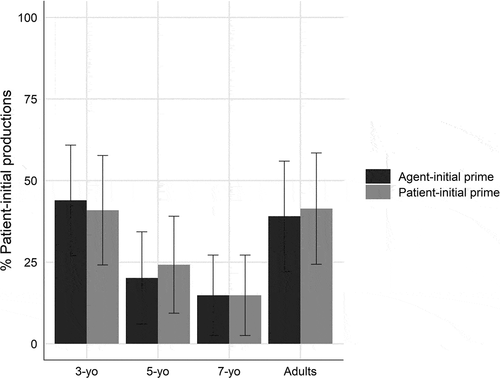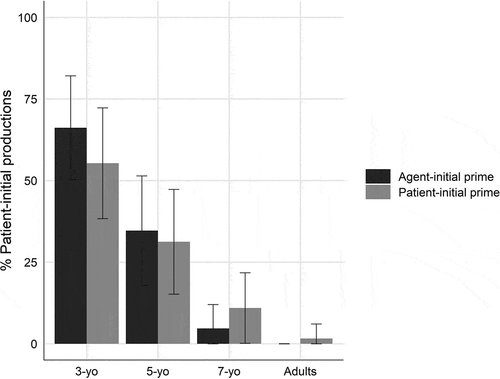Figures & data
Table 1. Sample experimental items for Experiment 1
Table 2. Summary of the fixed effects of age, thematic role order in the prime, voice-marking of the verb prompt and their interactions, on the frequency of children’s patient-initial productions in Experiment 1
Table 3. Summary of the fixed effects of age, thematic role order in the prime, voice-marking of the verb prompt and their interactions, on children’s accuracy in noun-marking in Experiment 1
Table 4. Sample experimental items for Experiment 2
Table 5. Summary of the fixed effects of age, thematic role order in the prime, voice-marking of the verb prompt and their interactions, on the frequency of children’s patient-initial productions in Experiment 2
Table 6. Summary of the fixed effects of age, thematic role order in the prime, voice-marking of the verb prompt and their interactions, on children’s accuracy in noun-marking in Experiment 2
Table 9. Summary of the fixed effects of age, thematic role order in the prime, voice-marking of the verb prompt and their interactions, on the frequency of children’s patient-initial productions in Experiment 1 after excluding single arguments and compound arguments (using at “and” between the nouns)
Figure 2. Mean percentage of patient-initial productions with 95% confidence intervals for each prime condition per age group given agent voice targets in Experiment 1

Figure 3. Mean percentage of patient-initial productions with 95% confidence intervals for each prime condition per age group given patient voice targets in Experiment 1

Figure 4. Percentage distribution of noun-marking types within each voice-marking condition per age group in Experiment 1. Note. AV refers to an agent voice-marked target prompt, and PV refers to a patient voice-marked target prompt

Figure 5. Mean percentage of patient-initial productions with 95% confidence intervals for each prime condition per age group given agent voice targets in Experiment 2

Figure 6. Mean percentage of patient-initial productions with 95% confidence intervals for each prime condition per age group given patient voice targets in Experiment 2

Figure 7. Percentage distribution of noun-marking types within each voice-marking condition per age group in Experiment 2. Note. AV refers to an agent voice-marked target prompt, and PV refers to a patient voice-marked target prompt

Table 7. The complete list of experimental items in Experiment 1. All of the verbs in the prime sentences were in the agent voice. AI refers to agent-initial, PI to patient-initial, AV to agent voice, and PV to patient voice
Table 8. The complete list of experimental items in Experiment 2. All of the verbs in the prime sentences were in the patient voice. AI refers to agent-initial, PI to patient-initial, AV to agent voice, and PV to patient voice
Table 10. Summary of the fixed effects of age, thematic role order in the prime, voice-marking of the verb prompt and their interactions, on the frequency of children’s patient-initial productions in Experiment 2 after excluding single arguments and compound arguments (using at “and” between the nouns)

